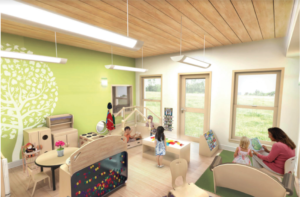Share on Facebook Share on Twitter Share on Linkedin
Leaders in Fort Worth and Tarrant County, Texas are working to expand access to high-quality infant and toddler care through Early Head Start. The below case study captures their story, including seven keys to success. Their work is a model for how to approach the challenging issue of expanding infant and toddler capacity. NHSA thanks Child Care Associates for sharing their work and experience.
Community leaders in Fort Worth and Tarrant County, Texas are like those in most of America: they want all young children to be safe, grow up healthy and ready for school, and thrive. Yet, they face enormous challenges due to entrenched poverty and a lack of affordable early care and education for families, especially for infants and toddlers.
In Tarrant County, 93% of children in families with low-incomes live in a child care desert, lacking access to subsidized child care, with 98% living in quality child care deserts. There is a particular lack of an infant and toddler infrastructure to ensure a balanced birth-to-five early childhood education system. While Early Head Start is a proven Head Start model to positively affect the brain development, health, and wellbeing of pregnant women and children from birth to age three, only one in 10 income-eligible children and their families have access to Early Head Start services.
Kara Waddell is an early childhood and Early Head Start leader at the center of transformation in Tarrant County. Waddell is the president and CEO of Child Care Associates (CCA), a leading provider of early care and education and family support. Currently, CCA operates 75 Head Start classrooms, serving 1,324 low-income preschoolers. In addition, they serve 492 infants, toddlers and pregnant women through 48 high-quality Early Head Start classrooms. CCA also manages child care funds, assisting 12,881 children of working families, providing direct services to over 200 child care programs to improve quality, and business coaching to over 400 more programs.
A Once-in-a-Decade Opportunity
For years, Waddell and her leadership team had been looking at the data showing tremendous need for infant and toddler care. They had engaged community leaders, but lacked the funding necessary to see that change occur. With the passage of historic, one-time federal funding to prop up communities during the COVID-19 pandemic, Waddell saw a once-in-a-decade opportunity to expand infant and toddler care.
In her words: “The federal recovery dollars provided the heat for the popcorn to pop.”
Pairing Early Head Start’s stable, federal funding and high-quality program with local American Rescue Plan Act (ARPA) dollars created a recipe for success that has been embraced by the larger community, leveraging $84 million dollars for improvements to the local early childhood landscape and resulting in a historic opportunity to achieve three major goals:
- Expand the number of local Early Head Start slots by 400 across 50 new classrooms, with a special focus on serving children and families with the highest need;
- Sustain these investments through a balanced portfolio of birth-to-five services, buoyed by federal Early Head Start and Head Start funding and state and local pre-K grants; and
- Raise wages and build jobs and career pathways for the local early childhood workforce.
A Blue Ribbon Action Committee on Infant and Toddler Care
For over five years, CCA and other community leaders witnessed the growing crisis in early education and care-a shortage of infant and toddler classrooms, child care locations that did not meet the community’s need, increased costs, and stagnant wages for the early childhood workforce resulting in rampant turnover. The COVID-19 pandemic only exacerbated the crisis.
In response, Fort Worth Mayor Mattie Parker, Arlington Mayor Jim Ross, Tarrant County Judge Glen Whitley, and CCA joined forces to form the Blue Ribbon Action Committee on Child Care (BRAC) to “capitalize on significant public investment opportunities from the ARPA and address longstanding issues in child care and early education.”
Mayor Parker has been a driving force behind the BRAC, making a strong business and economic case for early childhood investment.
“It just makes common business sense to invest in our youngest, the future of our workforce. We understand the majority of brain development happens between zero to five, yet our investment is often lopsided. When I speak to business leaders, their ears perk up. This is not how they would run their businesses, so why do we invest like this in our country? It does not make sense.”
The BRAC approach was critical to these local leaders, because they needed a way to engage different voices and perspectives and reach a consensus that included fresh thinking:
“[When identifying Committee members] We looked for people who were bold, innovative, and persuasive. We didn’t want the same ideas circulating that may not have worked previously, but rather, new ways of thinking to address persistent issues,” said Karin Scott, CCA’s chief performance officer.
With an intentional focus on innovative thinkers and diverse perspectives, the BRAC ended up with 16 members, 50% women and over 50% people of color, representing a wide spectrum of community service organizations and businesses.
4 Key Priorities for Expanding Access to Infant and Toddler Care
Ultimately, the BRAC settled on four key priorities:
- Expand and improve quality early education infrastructure, especially for infants and toddlers;
- Build a sustainable pipeline of quality early educators;
- Invest in community-based child care and have public and private options available for prekindergarten with a focus on a mixed delivery 0-5 system; and
- Transform the cost model into one that is sustainable through layered funding to cover the true costs of quality child care.
The BRAC’s focus on sustainability reflected the need to consciously address the limitations of the existing, broken way that early childhood is funded and the need to focus on the entire continuum of care from birth-to-five, to support the full spectrum of child development prior to Kindergarten entry.
“One of the greatest challenges is to break from doing the same thing repeatedly. We all still need infant and toddler care spaces, but we keep expanding preschool classrooms. We must expand our thinking to address a zero-to-five system as a whole,” said Catherine Davis, CCA’s director of policy.
The BRAC hired a data analytics company to examine, evaluate, and analyze five years’ worth of Head Start and other available data. Based on the assessment, the company develops predictive analyses and determines the long-lasting value of investments. In response, CCA and the BRAC set the goal of increasing the number of Early Head Start infant and toddler classrooms by 50, representing the opportunity to serve 400 more children with low-incomes and their families and rebalance available preschool and infant and toddler slots.
Reaching this goal requires a balance of ongoing funding and the one-time investments made possible by federal recovery funding and local decisions about how to allocate them. CCA’s work over the years, including community assessments, presentations to city councils, county leaders, and community organizations, positioned them to bring immediate concepts for funding to address the infant-toddler deserts and low percentages of Early Head Start services to the BRAC.
With COVID-19, CCA quickly began to think strategically about the challenges facing child care and how they were exacerbated by issues related to the pandemic. As a result of CCA’s efforts, the BRAC has been able to tackle the big issues facing the early childhood education system in their community by strategically funding efforts that address the current issues.
Funding Allocated to Support Early Head Start Expansion and Sustainability
As part of the $45 million ARPA approved by the Tarrant County Commissioners Court, $28 million in funding was allocated to expand infant-toddler access and infrastructure for highest-needs families. Through new public-private partnerships, the goal is to double the $28 million to $56 million through donated land, services, buildings, and resources. Tarrant County and CCA are launching a community call for proposals from other public entities for new public-private partnerships.
The Challenge Ahead: the Early Childhood Workforce
With respect to implementation, Waddell and her team inevitably mentioned the challenge of finding and retaining the early childhood workforce, which has seen such rapid burnout and turnover. CCA has employed a variety of creative efforts in their programs, including:
- Monthly stipends paid for with COVID relief dollars;
- Helping eligible teachers apply for Texas Workforce Commission sustainability grants; and
- Working with local child care providers, high schools, and community colleges to establish apprenticeship programs.
Community-wide, they have helped to enroll over 400 early childhood staff in apprenticeship programs and pay 100% tuition for those seeking an Associates of Arts or Bachelors of Arts through a statewide effort funded through Texas Workforce Commission investments and local workforce boards.
As a rule, CCA administrators take pride that so many of the teachers they hire and train move into elementary school classrooms where they may earn more, but the children and families in CCA programs feel that sting.
“They [CCA teachers] develop skills and then go out into our community to continue to serve children, but the turnover and loss is happening at a great pace right now. It’s too fast. It goes beyond wages. We have to take a look at burnout and how to help staff feel supported by the team and at work. We are working on creating desirable jobs with wellness models, paid time off and support for educational goals,” said Scott.
Building Greater State Support
Waddell acknowledges that state policy is critical to support creative local efforts, such as the one she helps to lead. Among her wish list for Texas early childhood policy:
- A truly integrated and aligned prenatal-to-five system with a mix of community, school and Head Start options;
- Expanded use of contracts (versus vouchers) in child care funding, which would particularly help to stabilize child care and strengthen Early Head Start; and
- Data sharing across states, localities, and various service delivery organizations, including child and workforce data.
Above all, Waddell recognizes that any effort local, state or federal to improve early care and education, especially at the scale being driven by CCA and the BRAC, has to be driven by high levels of accountability and stewardship.
“If we are publicly funded, we have to be publicly accountable.”
Katie Dufford-Melendez
Seven Key to Success in Expanding Access to Early Head Start
1. Expand Early Head Start Expand
With a coordinated prenatal-to-five system in mind, Early Head Start was the logical place to start with its comprehensive services for pregnant moms and children from birth to age three and high quality performance standards. According to CCA, Early Head Start spaces were so coveted, families drove from 20 miles away to access services when they were accepted into the program. While the base model is Early Head Start, CCA blends funding and services to ensure flexibility of services and meet the unique needs of each family.
Later, when Waddell was reaching out to the local child care community who expressed concern that their paid slots may be at risk, she explained the economic position of Early Head Start-eligible families: “Early Head Start families cannot afford the child care programs; they are families who would go unserved.”
2. Convert Enrollment Slots Expand
Services for pregnant women, infants, and toddlers which require shifting Head Start funding, strategic planning, and the development and implementation of new processes to ensure the Early Head Start Performance Standards are met. The HS2EHS converted slots create more infant and toddler options within the community and are particularly viable when state or local funding preschool programs are meeting a significant share of demand for Head Start’s preschool services.
3. Build EHS-Child Care Partnerships Expand
Expand infant and toddler options by blending services from providers who participate in the Child Care and Development Fund (CCDF) with Early Head Start programs, to enhance early education and support for low-income children and their families. The partnerships provide quality programming and flexibility, often through full-day and full-year services, to meet the needs of working families or those in education and career training programs.
CCA’s Chief Financial Officer Karanae Spradlin used these strategies to develop an efficient cost model to build stakeholder buy-in and to amend contracts with existing providers to create new slots. To extend the day for working families, they examined current child care options through CCDF and explored how to provide additional hours at the beginning and/or end of the day. The modeling allowed them to make the argument that a one-time investment with federal funding would pay off through decades of returns.
4. Focus on Space and Locations Expand
One of the biggest barriers CCA and the BRAC faced was infrastructure. Old and poorly located spaces do not allow for convenient and equitable access for infants, toddlers, and their families. Typically, there are no public dollars available for early childhood facilities and renovations. With this unique one-time opportunity, CCA and the BRAC gave careful consideration to placement of the infant and toddler slots and classrooms and removed these barriers to access. Returning to the Early Head Start and Head Start data, they examined locations, deserts, and community needs and worked toward creative solutions.
Modular buildings are being constructed to create new centers in locations where they are needed most. Modular buildings can be built quickly and the space customized to meet CCA’s needs. According to Waddell: “Modular buildings go up fast and can be customized to allow families to make decisions for the outside and play areas.”
CCA also identified six Head Start classrooms in school buildings that will be converted to infant and toddler classrooms. They looked at other school-based programs to focus on teen parents and children of non-instructional staff who may need early education and care, such as cafeteria workers. They are currently exploring working with the local community college, to find space to support young students who may need child care support to finish their education.
The team hired a consulting firm to use data, technology, and analytics to identify core families and find locations to place the new classrooms so that it meets families where they are and meet their needs. They examined the typical course schedules of college students, eligible parents’ work places and non-traditional employment patterns. They considered the location of grandparents and other family members who may provide transportation for the children to child care. They learned the best location is not necessarily where eligible families live, but all of these other considerations that make child care more accessible and convenient.
5. Design Quality Classrooms Expand
CCA served as the early childhood education and care experts, guiding the BRAC on identifying EHS as the infant toddler model, how to define, measure, and improve quality, and how to create classrooms that will serve children, families, and teachers for years to come. Because they serve children and families with the greatest needs, they knew they wanted trauma-informed classrooms, but what does that look like and is that enough? They consulted varying points of view, including Montessori specialists, the National Association for the Education of Young Children, and prekindergarten programs. With so much invested, they wanted to get the classrooms “right” on the first try.
They started with the basics, identifying what young children need and designed classrooms to match. This meant more space per child in the classrooms, using neutral and calming colors for the walls and furniture, and creating natural play areas. They put together three-dimensional models so it became easier to envision the space and look at ways they could enhance it. They spoke to teachers and parents about what they needed. Teachers felt they needed more windows, for example, not necessarily to the outside but even between classrooms so they could see each other and feel less isolated by classroom walls. Teachers needed a place to store their personal belongings when they came to work, a place to rest during their breaks, and a charging station for their electronic devices and phones. They looked at the individual wellness needs of teachers. In one case, it meant making sure the space was large enough to accommodate a teacher’s mobility scooter.
Parents were consulted as well. They asked for a covered drop off area for days with inclement weather. They requested a stroller or car seat “garage” to store them during the day when the pickup parent/grandparent is different from the one who dropped off the child in the morning. Finally, they asked for a place to store their bags and phones when in the center volunteering.
The overall goal of CCA is to create Early Head Start spaces that will move beyond current practices and are ready for future needs through careful planning.
6. Create Community Buy-in Expand
With tens of millions of dollars directed toward the project, ensuring they are invested wisely was a primary goal. CCA and the BRAC had to ensure commitment from the community. Messaging was key to ensuring the plan would be implemented fully.
Investors and decision-makers were provided with financial modeling to outline the upfront costs and predict the future return on investments. Costs associated with serving infants and toddlers are often high compared to preschool costs. CCA worked with financial institutions and other stakeholders to help them understand the true cost of serving infants and toddlers, often comparing the cost to families to educate young children with the costs of a college education, an expense a family saves for years to afford.
At the child-level, the investment may look costly. However, CCS helped stakeholders to visualize the impact at the classroom level as well as in the broad number of the community’s most vulnerable children to be served over ten years.The impact of adding 50 classrooms over ten years provides a robust return on the initial investment. .
CCA also wanted to assure valued community child care providers understood the expansion efforts so that they could see the need. They engaged in dialogue with child care programs to help them understand that Early Head Start was not competing for families, but would help to serve an unserved population, with few or no options. Tangibly, they reached out to existing child care programs centers to secure their support prior to any project goals being set or press releases issued. Reaching out to current providers was an important step in creating early childhood community buy-in, especially among other strong providers. As Waddell noted: “[Having these discussions] helped to defuse the worry, underscoring that we are adding to the community, not competing with existing quality programs.”
7. Use Data to Guide Quality Expand
For Scott, Censuring quality early education and care comes down to data. Her goal has always been to establish policies for collecting strong data, working with staff on the ground to understand the importance of the information they are collecting, and then teaching them how to use it to impact instruction and overall quality.
Good data collection is especially important in early childhood education, where high teacher turnover is an unfortunate reality. Therefore, CCA builds capacity to gather and utilize data at the director and manager level where the turnover is lower. That builds decision-making power at the campus level rather than from headquarters.
The data points CCA to families who may benefit the most from EHS services. They partner with other organizations, such as Catholic Charities, to find and serve the most vulnerable families, especially pregnant women where children may receive the highest EHS dose of services and support from the beginning.
The Early Head Start Performance Standards set the tone for quality. CCA uses multiple data points, such as the standards to examine child development outcomes, Classroom Assessment Scoring System (CLASS®) scores for teacher-child interactions, and other environmental data points to identify organizational conditions, leadership support, and classroom environments to push for higher quality and stronger child outcomes.
CCS ensures these same quality indicators reach beyond the Early Head Start/Head Start classrooms and into other child care centers. They look to see what works in Early Head Start/Head Start centers and expand that into other areas of the community. They work with parents and community organizations that may have varying expectations to frame the standards and measures and why they are important to quality and build strong educational experiences for children and their families. They work with child care providers to incorporate quality indicators in the quality rating and improvement systems.
 Child Care Associates Classroom Rendering
Child Care Associates Classroom Rendering  Child Care Associates Morris Campus in Fort Worth, Texas on May 27, 2022. (Photo/Sharon Ellman)
Child Care Associates Morris Campus in Fort Worth, Texas on May 27, 2022. (Photo/Sharon Ellman)  Child Care Associates Classroom Rendering
Child Care Associates Classroom Rendering  Child Care Associates Morris Campus in Fort Worth, Texas on May 27, 2022. (Photo/Sharon Ellman)
Child Care Associates Morris Campus in Fort Worth, Texas on May 27, 2022. (Photo/Sharon Ellman)  Child Care Associates Morris Campus in Fort Worth, Texas on May 27, 2022. (Photo/Sharon Ellman)
Child Care Associates Morris Campus in Fort Worth, Texas on May 27, 2022. (Photo/Sharon Ellman)  Child Care Associates Morris Campus in Fort Worth, Texas on May 27, 2022. (Photo/Sharon Ellman)
Child Care Associates Morris Campus in Fort Worth, Texas on May 27, 2022. (Photo/Sharon Ellman)  Child Care Associates Morris Campus in Fort Worth, Texas on May 27, 2022. (Photo/Sharon Ellman)
Child Care Associates Morris Campus in Fort Worth, Texas on May 27, 2022. (Photo/Sharon Ellman)